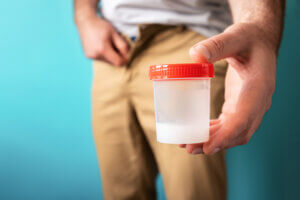Learn the science behind sperm washing before your fertility treatment
 It’s time for your IUI, and your partner has been instructed on how to collect his sperm. He’s shown to the collection room with a plastic specimen cup and told that after collection his semen sample will be washed before the procedure. What? Are his sperm dirty? How is sperm washing even done?
It’s time for your IUI, and your partner has been instructed on how to collect his sperm. He’s shown to the collection room with a plastic specimen cup and told that after collection his semen sample will be washed before the procedure. What? Are his sperm dirty? How is sperm washing even done?
Sperm washing is the process in which individual sperm cells are separated from the semen fluid. Sperm washing semen samples is required for the many different fertility treatments at our clinic, such as intrauterine insemination (IUI), before IVF fertilization using intracytoplasmic sperm injection (ICSI), and before sperm freezing. Chances are that if you are undergoing one of these procedures, your semen will be washed.
Why do we need sperm washing?
There are many scientific reasons why semen samples are washed before fertility treatments. First and foremost, semen contains prostaglandins that can cause severe cramping if introduced inside the uterus. Seminal fluid also contains debris in the form of white blood cells and dead sperm cells, which can impair fertilization of the egg. Additionally, bacteria or viruses in the seminal fluid can lead to infection if introduced into the uterine cavity.
During normal sexual intercourse, your cervix plays an important role as gatekeeper to protect the uterine cavity and the upper genital tract from prostaglandins, debris and infectious substances. As seminal fluid enters, your cervix acts as a natural biologic “sperm washer”, removing the prostaglandins, debris and bacteria from the semen.
However, since fertility treatments such as IUI and IVF bypass the cervix, the sperm needs to be “washed” in our lab before using in these procedures. The main purpose of sperm washing is to segregate motile (swimming) sperm from immotile and dead sperm and to remove prostaglandins and bacteria.
How do you wash sperm?
Sperm washing takes place in our andrology laboratory following semen collection. Different techniques of sperm washing are used depending on what it will be used for and how good the sample is. The end result is a small volume of highly concentrated motile sperm that is safe to introduce in the sterile environment of the uterine cavity during an IUI procedure or to use to fertilize the egg in the lab during an IVF procedure.
- Density Gradient Sperm Wash – This procedure separates dead sperm cells, white blood cells and other waste products from the sperm. A test is tube filled with a dense media concentration and the semen sample is placed on top, then the test tube is spun in a centrifuge. After spinning, healthy sperm will be collected in the bottom of the concentration. Dead sperm and other debris will be trapped in the top. This method is most often used when the sample is good quality (high count, motility and morphology). The result is a highly concentrated, purified sample for IUI.
- Swim Up Technique – This process is done is a conical tube. The semen sample is centrifuged to a pellet then a layer of media is placed over pellet and the sample is allowed to sit for an hour. Then, the top of the media is pulled off and the motile sperm swim to the top and are collected. This technique is most often used when we have samples with normal count, motility and morphology. Since only the sperm that can swim up to the culture media are collected, it ensures only the healthiest, strongest sperm are used in IUI.
- Simple Sperm Wash – In this method, media is added to the semen sample, then centrifuged. White blood cells and debris are separated out and viable sperm is concentrated in a pellet to be collected. This method has the lowest loss of viable sperm and is good for poor semen samples (low count, motility and/or morphology).
After sperm washing, the isolated motile sperm can be placed directly into the uterus during an IUI, bypassing the vagina and cervix. An IUI catheter deposits the sperm into close proximity to the fallopian tubes, where eggs are fertilized.
Sperm washing is also used during IVF cycles for ICSI fertilization. In this procedure, a single sperm is selected and injected directly into the egg under a microscope. Having a washed, concentrated sample enables our embryologists to more efficiently select highly motile and quality sperm.


